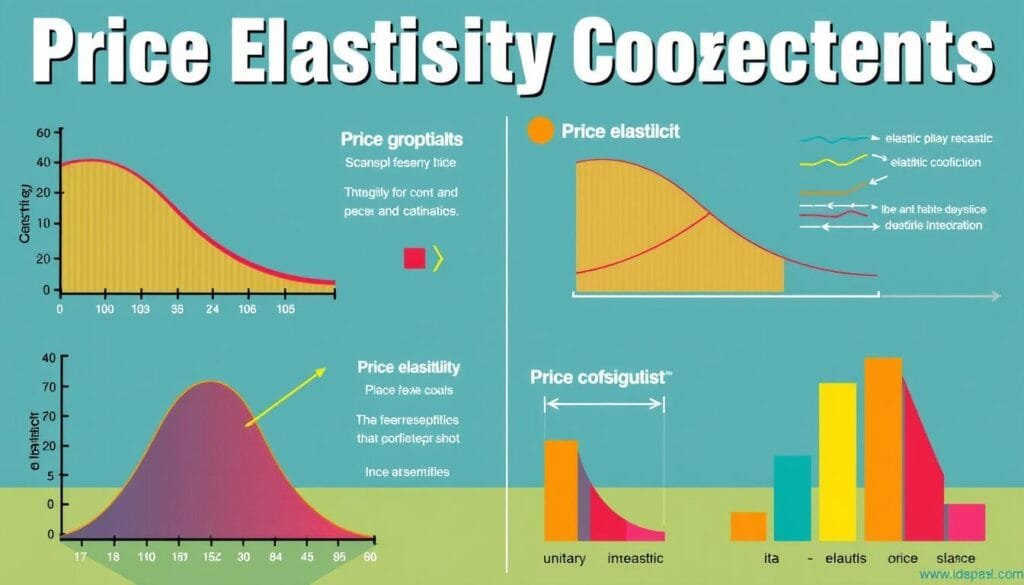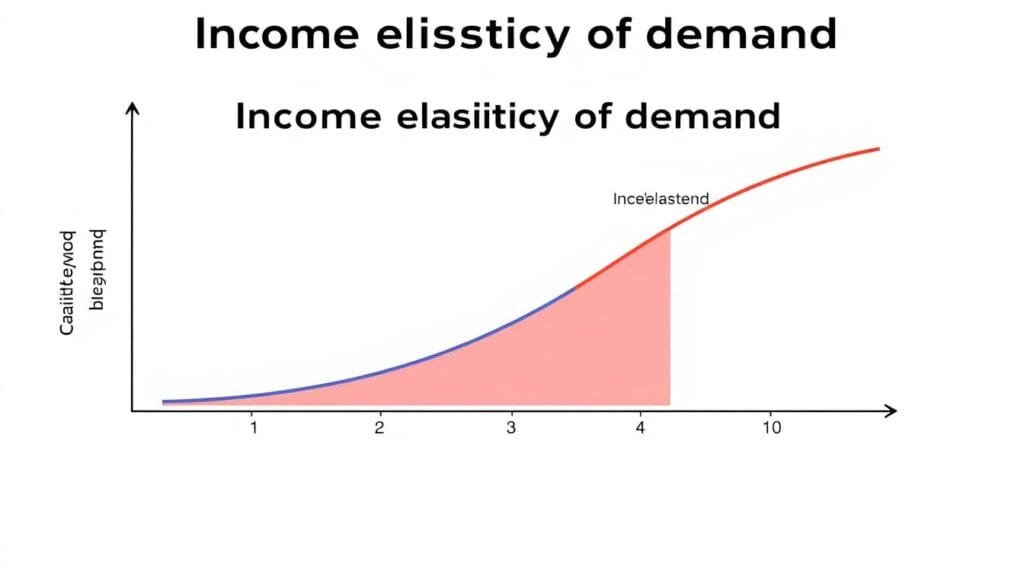Elasticity in economics is crucial. It shows how connected it is to market dynamics. By looking at how the need for a product can change, we learn about the market’s nature. Understanding elasticity helps us navigate the market better.
It lets us know if our products are elastic or inelastic. This knowledge is key when prices or incomes change. It shapes how we plan, predict, and succeed in the market.
Key Takeaways
- Elasticity in economics is a reflection of how demand or supply adjusts in response to price or income changes.
- Understanding the elasticity of goods aids businesses and economists in predicting consumer behavior and market outcomes.
- Market dynamics are significantly influenced by the demand fluctuation of various goods and services within the economy.
- The distinction between elastic and inelastic goods plays a critical role in pricing strategies and economic modeling.
- Categories like inelastic, elastic, and perfectly elastic goods offer insights into consumer priorities and value perceptions.
Introduction to Elasticity in Economic Terms
Elasticity is key in economics. It shows how things in the market respond to each other. The elasticity definition tells us how an economic variable reacts when another changes. This concept is vital for setting prices, understanding the market, and making smart fiscal policies.
Demand elasticity shows us how demand for a product changes with its price. It’s important for both businesses and consumers. For example, knowing if consumers will stop buying if prices go up helps companies decide on pricing.
Defining Elasticity in Economics
Elasticity can be divided into types like price elasticity, income elasticity, and cross-elasticity. They all give insight into how the market reacts. Price elasticity reveals how a change in price affects demand. When a product’s price changes slightly, and demand shifts a lot, it has high elasticity.
The Importance of Elasticity for Market Analysis
Understanding elasticity helps businesses decide on prices and manage inventory. It also helps the government make policies that keep markets running smoothly. Knowing how the market reacts to changes helps predict consumer behavior. This prediction is crucial for future economic planning.
The more a market can adapt, the better it runs. When businesses adjust prices based on demand elasticity, it impacts their earnings and what people buy. This adaptation is crucial for economic health.
In conclusion, understanding elasticity helps businesses and policymakers make better decisions. This knowledge creates a market that serves consumers well, supporting a strong economy.
What is Elasticity in Economics
Economic elasticity looks at how a product or service’s demand or supply reacts to changes in economic factors. These factors include price, income, and prices of related goods. We focus on three key types of elasticity: price elasticity, income elasticity, and cross elasticity. They affect consumers and businesses every day.
Price Elasticity of Demand and Supply
Price elasticity of demand measures how demand for a product changes with its price. Essential goods like medicine show little change in demand when prices change. But for luxury items, demand changes a lot with price changes. Our resources show knowing this helps businesses set the right prices to keep customers.
Supply elasticity looks at how the supply of a product changes when its price does. For products easy to make more of, like many manufactured goods, supply changes quickly with price changes. This lets producers adjust fast to market changes.
Income Elasticity of Demand
This shows how demand for products changes with changes in consumer income. Products are seen as normal or inferior based on if demand goes up or down with income. Luxury cars, for example, might see demand rise with higher incomes, showing positive elasticity. But generic brands might see demand fall, indicating negative elasticity.
Cross Elasticity of Demand
Cross elasticity sees how demand for one product changes when another product’s price changes. If tea gets more expensive and people buy more coffee because of it, it shows positive cross elasticity. This is key for businesses in markets with products that can replace each other.
Knowing these elasticity types helps businesses foresee market trends and make smart decisions on pricing, production, and marketing. It helps economists and marketers create strategies that match how people behave and the broader economy. This can lead to more profit and a bigger market share.
Factors Affecting Elasticity of Demand
Understanding determinants of demand elasticity helps businesses and economists predict market trends. Several factors, like substitute availability, whether goods are necessities or luxuries, and the time factor, greatly affect it.
Availability of Substitutes
Substitute availability dramatically impacts demand elasticity. If many alternatives exist, people can switch products based on price changes easily. This leads to higher elasticity because demand quickly responds to price adjustments. For example, many cereal brands can replace each other, making their demand elastic.
Role of Necessities vs. Luxuries
Whether a product is a necessity or a luxury also influences its elasticity. Necessity goods, like food and healthcare, have inelastic demand. Prices changes little affect their demand. In contrast, luxury goods like fancy gadgets or designer clothes show more elastic demand. People might postpone buying these if prices go up.
The Impact of Time on Elasticity
The time factor is crucial in determining elasticity. In the short term, demand often remains inelastic because people don’t quickly change their habits. Over time, though, they find substitutes or alter their habits. This shows how important time is in understanding demand elasticity.

In summary, knowing about determinants of demand elasticity is crucial. Factors like substitute availability, necessity versus luxury goods, and the time factor help predict market behavior. These factors explain why different products react differently to price changes and aid in planning business strategies.
Price Elasticity: Understanding Consumer Behavior
In today’s market, knowing how consumers react to price changes is key. We call this price elasticity coefficients. They show consumer responsiveness to price changes. Knowing this helps companies decide on pricing.

There are elastic goods and inelastic goods. Elastic goods like luxury items change a lot in demand with small price changes. But inelastic goods, such as necessities or health products, don’t change much in demand when prices shift. This difference is critical for marketing and pricing plans.
Interpreting Price Elasticity Coefficients
To understand price elasticity coefficients, we look at the change in demand over the change in price. Take a name-brand microwave that gets 20% more expensive and sees a 25% drop in sales. This gives it an elasticity of 1.25. It’s an elastic product because demand falls sharply with a price rise.
Examples of Elastic and Inelastic Goods
Elastic goods, like big-screen TVs and airline tickets, are very sensitive to price. When prices go up, their demand can drop quickly. But inelastic goods like gas and basic healthcare don’t change much in demand with price hikes. These items are seen as necessary.
For more on price elasticity, please visit price elasticity of demand.
Income Elasticity of Demand: A Closer Look
Understanding the income elasticity of demand is key for examining how changes in consumer income affect demand for products. This measure lets us identify if products are seen as normal goods, inferior goods, or luxury items. It shows how their demand changes with income variations.
How Income Changes Affect Demand
The concept of income elasticity of demand shows that demand for products changes as consumer incomes go up or down. A formula calculates this by dividing the change in quantity demanded by the change in income. For companies, this knowledge helps forecast sales changes with economic shifts.
Normal Goods vs. Inferior Goods
Understanding the difference between normal goods and inferior goods sheds light on consumer choices. Normal goods see higher demand as incomes increase. But, inferior goods are less in demand as incomes go up.
| Good Type | Description | Examples | Income Elasticity |
|---|---|---|---|
| Normal Goods | Demand increases as income increases | Haircuts, Premium Cars | Positive (>0, <1 for necessities, >1 for luxuries) |
| Inferior Goods | Demand decreases as income increases | Margarine, discount store brands | Negative |
| Luxury Goods | High sensitivity to income changes | Jewelry, gourmet products | Greater than 1 |
The table above explains how consumer income impacts demand. It organizes goods by their response to income changes. This is vital for businesses planning marketing strategies and forecasting trends based on economic predictions.

Grasping the income elasticity of demand helps firms refine their product and marketing plans. It ensures they cater to shifts in consumer buying power and preferences, especially between normal goods and inferior goods.
Cross Elasticity of Demand: The Influence of Related Products
The concept of cross elasticity of demand is key when we talk about the market. It shows how one product’s price change affects another’s demand. It sheds light on substitute and complementary goods and consumer choices. This knowledge helps businesses plan their strategies better.
Substitutes and Complements
For substitute goods, a price hike in one leads to more demand for another. This shows a positive cross-price elasticity. For example, if one coffee brand becomes pricier, another might see more sales. They are considered close substitutes. Conversely, complementary goods have a negative cross elasticity. Like when printers get costlier, fewer ink cartridges sell because they go hand in hand.
Measuring Cross-Price Elasticity
To gauge cross-price elasticity well, we look at demand changes versus price changes. This helps companies see how products relate as substitutes or complements. They can then make smarter pricing and marketing choices. The table below shows examples of how cross elasticity plays out in real life:
| Product A | Product B | Type of Relationship | Cross Elasticity |
|---|---|---|---|
| Starbucks Coffee | Costa Coffee | Substitute Goods | High Positive |
| Printers | Ink Cartridges | Complementary Goods | Negative |
| Digital Cameras | Film Rolls | Unrelated Goods | Zero |
Understanding cross elasticity helps with pricing, product placement, and segmentation. It shows how price changes affect demand between products. By grasping this, companies can use these relationships to their advantage. Or, they can boost brand loyalty to lessen the effects of substitutes.
The Significance of Elasticity for Businesses
Understanding business elasticity is key for businesses to effectively deal with the market’s ups and downs. It affects important stuff like pricing strategy, product development, and market placement. By getting elasticity, companies can set smart prices and make products that meet changing customer needs and face competitors head-on.
Pricing Strategies and Elasticity
Using price elasticity insights helps businesses price their products to sell more and make more money. Products that are elastic, meaning sales change with price, might be priced lower to sell more. On the other hand, inelastic products, which don’t lose sales with price hikes, can keep prices steady. This helps businesses stay competitive and plan their finances and strategies better.
Product Development and Market Placement
In making and placing products, knowing about elasticity is super helpful. If a product is elastic, a company might make it stand out by improving it or adding new stuff. This helps even if the market’s crowded. But if a product is inelastic, it’s a chance to make customers more loyal and happy. This secures a steady place in the market for the business.
The idea of elasticity is super important in making strong business moves. It guides pricing, product making, and how to introduce products to the market. By understanding this economic concept, businesses can quickly adjust to new market trends and what customers want. This gives them a big advantage in staying ahead.
Conclusion
Economic responsiveness is key in understanding market dynamics. It’s about knowing how changes in prices or competition affect us. This knowledge helps us predict and react wisely to market changes.
Small businesses and governments alike benefit from understanding elasticity. It shows how price changes impact demand. This knowledge helps plan pricing strategies and optimize revenue, even when the market shifts.
Grasping the concept of demand elasticity is crucial. It helps predict consumer behavior related to prices and income. This insight is vital for anyone, from lemonade stands to large international businesses. It’s essential for staying ahead in the market.
FAQ
What does elasticity in economics refer to?
Elasticity in economics shows how demand or supply for a product changes with another factor. This could be due to price changes, income variations, or different available substitutes.
Why is understanding demand elasticity important for market analysis?
Knowing demand elasticity is key for market analysis. It predicts how price changes affect product demand. This information is essential for setting prices, managing supplies, and forecasting finances.
How do you define price elasticity of demand?
Price elasticity of demand measures how much the demand for a product changes with its price. It’s the percentage change in quantity demanded over the percentage change in price.
What is income elasticity of demand?
Income elasticity of demand looks at how consumer income changes affect demand for a product. It shows if a product is a normal good (demand grows with income) or an inferior good (demand falls with income).
Can you explain cross elasticity of demand?
Cross elasticity of demand checks how the demand for one product reacts to price changes in another. If the good is a substitute, the demand increases with the substitute’s price rise. For complements, demand drops if the complement’s price goes up.
What factors determine the elasticity of demand for a product?
Many factors affect demand elasticity. These include substitute availability, if the good is essential or a luxury, how much of one’s income is spent on it, and the time customers need to adjust their choices.
How do price elasticity coefficients interpret consumer behavior?
Price elasticity coefficients tell us how price changes influence demand for a product. A coefficient above one means demand is elastic. Below one means it’s inelastic.
What are examples of elastic and inelastic goods?
Elastic goods are luxury items and non-essential services with demand that changes sharply with price. Inelastic goods like basic foods, healthcare, and gasoline have stable demand despite price changes.
How do income changes affect the demand for normal and inferior goods?
As income rises, people buy more normal goods, showing positive income elasticity. Demand for inferior goods drops when income goes up, reflecting negative income elasticity.
What is the relevance of substitutes and complements in cross elasticity of demand?
Substitutes and complements are crucial in understanding cross elasticity of demand. They affect how demand for one product reacts to price changes of another. This impacts consumer choices and demand elasticity for related goods.
How does elasticity influence pricing strategies for businesses?
Elasticity helps businesses foresee how price changes could impact demand. For elastic goods, a price hike might lower demand significantly. For inelastic goods, demand stays stable even if prices go up. This guides businesses to price products to maximize earnings and market presence.
Why is elasticity important for product development and market placement?
Elasticity is vital for creating and placing products in the market. It helps businesses design products that meet demand sensitivity and choose markets with favorable elasticity. This ensures a successful launch and ongoing success.
